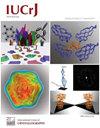基于二维模板匹配的低温电镜鲁棒目标检测新统计度量。
IF 3.6
2区 材料科学
Q2 CHEMISTRY, MULTIDISCIPLINARY
引用次数: 0
摘要
二维模板匹配(2D template matching, 2DTM)可用于细胞低温电镜图像中分子及其组装的检测,具有较高的位置和方向精度。虽然2DTM成功地检测了大核糖体亚基等球形靶标,但在各种环境中检测更小、更非球形靶标仍然存在挑战。在这项工作中,开发了一种新的2DTM度量,称为2DTM p值,以将2DTM框架扩展到更复杂的应用中。2DTM p值结合了之前使用的两个2DTM指标的信息,即2DTM信噪比(SNR)和z-score,它们是由目标和模板之间的相互关联系数得出的。在各种成像和样品条件下,2DTM p值显示出稳健的检测精度,并且优于单独的2DTM信噪比和z分数。具体来说,2DTM p值提高了对模拟数据中修饰的人工微管蛋白贴片颗粒(500 kDa)和更小的网格蛋白单体(193 kDa)等非球状目标的检测。即使在高斯噪声增加的条件下,该方法也能准确地恢复酵母片样中的成熟60S核糖体。新的指标将能够通过2DTM在纯化和细胞样品中检测更广泛的靶标。本文章由计算机程序翻译,如有差异,请以英文原文为准。
A new statistical metric for robust target detection in cryo-EM using 2D template matching
A novel statistical metric for 2D template matching (2DTM), the 2DTM p-value, has been developed to improve the detection of targets in cryo-EM images under various imaging and sample conditions, particularly for smaller and aspherical targets.
2D template matching (2DTM) can be used to detect molecules and their assemblies in cellular cryo-EM images with high positional and orientational accuracy. While 2DTM successfully detects spherical targets such as large ribosomal subunits, challenges remain in detecting smaller and more aspherical targets in various environments. In this work, a novel 2DTM metric, referred to as the 2DTM p-value, is developed to extend the 2DTM framework to more complex applications. The 2DTM p-value combines information from two previously used 2DTM metrics, namely the 2DTM signal-to-noise ratio (SNR) and z-score, which are derived from the cross-correlation coefficient between the target and the template. The 2DTM p-value demonstrates robust detection accuracies under various imaging and sample conditions and outperforms the 2DTM SNR and z-score alone. Specifically, the 2DTM p-value improves the detection of aspherical targets such as a modified artificial tubulin patch particle (500 kDa) and a much smaller clathrin monomer (193 kDa) in simulated data. It also accurately recovers mature 60S ribosomes in yeast lamellae samples, even under conditions of increased Gaussian noise. The new metric will enable the detection of a wider variety of targets in both purified and cellular samples through 2DTM.
求助全文
通过发布文献求助,成功后即可免费获取论文全文。
去求助
来源期刊

IUCrJ
CHEMISTRY, MULTIDISCIPLINARYCRYSTALLOGRAPH-CRYSTALLOGRAPHY
CiteScore
7.50
自引率
5.10%
发文量
95
审稿时长
10 weeks
期刊介绍:
IUCrJ is a new fully open-access peer-reviewed journal from the International Union of Crystallography (IUCr).
The journal will publish high-profile articles on all aspects of the sciences and technologies supported by the IUCr via its commissions, including emerging fields where structural results underpin the science reported in the article. Our aim is to make IUCrJ the natural home for high-quality structural science results. Chemists, biologists, physicists and material scientists will be actively encouraged to report their structural studies in IUCrJ.
 求助内容:
求助内容: 应助结果提醒方式:
应助结果提醒方式:


